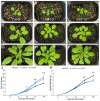CLAVATA3 Signaling Buffers Arabidopsis Shoot Apical Meristem Activity in Response to Photoperiod
- PMID: 39273306
- PMCID: PMC11394970
- DOI: 10.3390/ijms25179357
CLAVATA3 Signaling Buffers Arabidopsis Shoot Apical Meristem Activity in Response to Photoperiod
Abstract
Land plants grow throughout their life cycle via the continuous activity of stem cell reservoirs contained within their apical meristems. The shoot apical meristem (SAM) of Arabidopsis and other land plants responds to a variety of environmental cues, yet little is known about the response of meristems to seasonal changes in day length, or photoperiod. Here, the vegetative and reproductive growth of Arabidopsis wild-type and clavata3 (clv3) plants in different photoperiod conditions was analyzed. It was found that SAM size in wild-type Arabidopsis plants grown in long-day (LD) conditions gradually increased from embryonic to reproductive development. clv3 plants produced significantly more leaves as well as larger inflorescence meristems and more floral buds than wild-type plants in LD and short-day (SD) conditions, demonstrating that CLV3 signaling limits vegetative and inflorescence meristem activity in both photoperiods. The clv3 phenotypes were more severe in SDs, indicating a greater requirement for CLV3 restriction of SAM function when the days are short. In contrast, clv3 floral meristem size and carpel number were unchanged between LD and SD conditions, which shows that the photoperiod does not affect the regulation of floral meristem activity through the CLV3 pathway. This study reveals that CLV3 signaling specifically restricts vegetative and inflorescence meristem activity in both LD and SD photoperiods but plays a more prominent role during short days.
Keywords: Arabidopsis; CLV; carpel; meristem; peptide; photoperiod; rosette; signaling; stem cells.
Conflict of interest statement
The author declares no conflicts of interest.
Figures





Similar articles
-
Control of Arabidopsis shoot stem cell homeostasis by two antagonistic CLE peptide signalling pathways.Elife. 2021 Oct 13;10:e70934. doi: 10.7554/eLife.70934. Elife. 2021. PMID: 34643181 Free PMC article.
-
The signaling peptide-encoding genes CLE16, CLE17 and CLE27 are dispensable for Arabidopsis shoot apical meristem activity.PLoS One. 2018 Aug 16;13(8):e0202595. doi: 10.1371/journal.pone.0202595. eCollection 2018. PLoS One. 2018. PMID: 30114285 Free PMC article.
-
Photoperiod regulates flower meristem development in Arabidopsis thaliana.Genetics. 2005 Feb;169(2):907-15. doi: 10.1534/genetics.104.033357. Epub 2004 Oct 16. Genetics. 2005. PMID: 15489527 Free PMC article.
-
Coming into bloom: the specification of floral meristems.Development. 2009 Oct;136(20):3379-91. doi: 10.1242/dev.033076. Development. 2009. PMID: 19783733 Review.
-
Regulation of Flowering Time: When and Where?Curr Opin Plant Biol. 2021 Oct;63:102049. doi: 10.1016/j.pbi.2021.102049. Epub 2021 May 8. Curr Opin Plant Biol. 2021. PMID: 33975153 Review.
References
MeSH terms
Substances
Grants and funding
LinkOut - more resources
Full Text Sources
Research Materials

